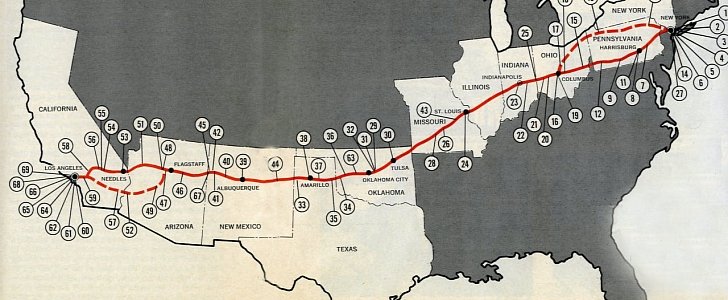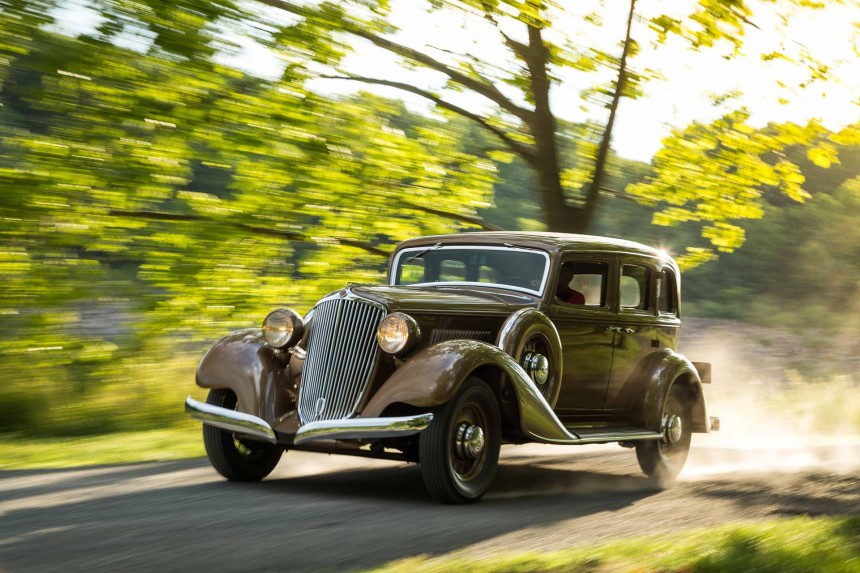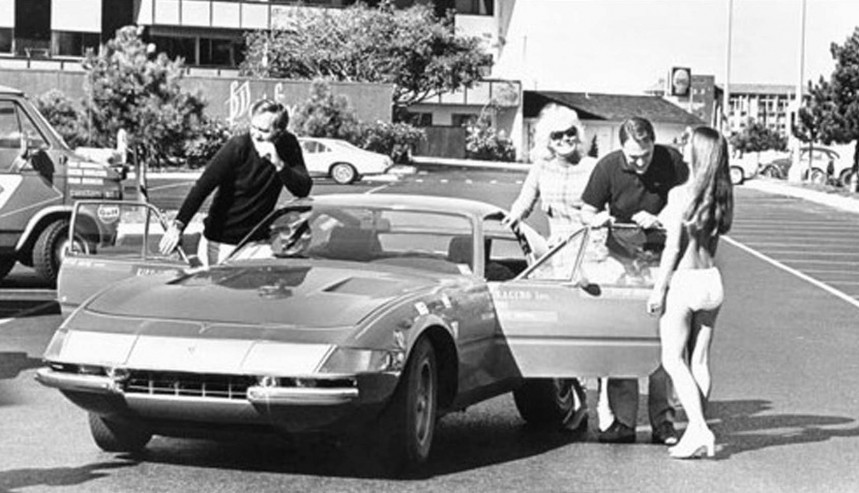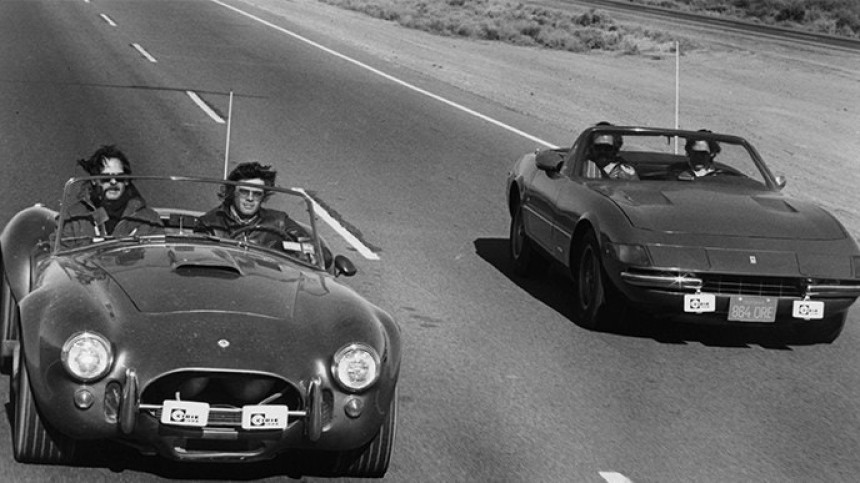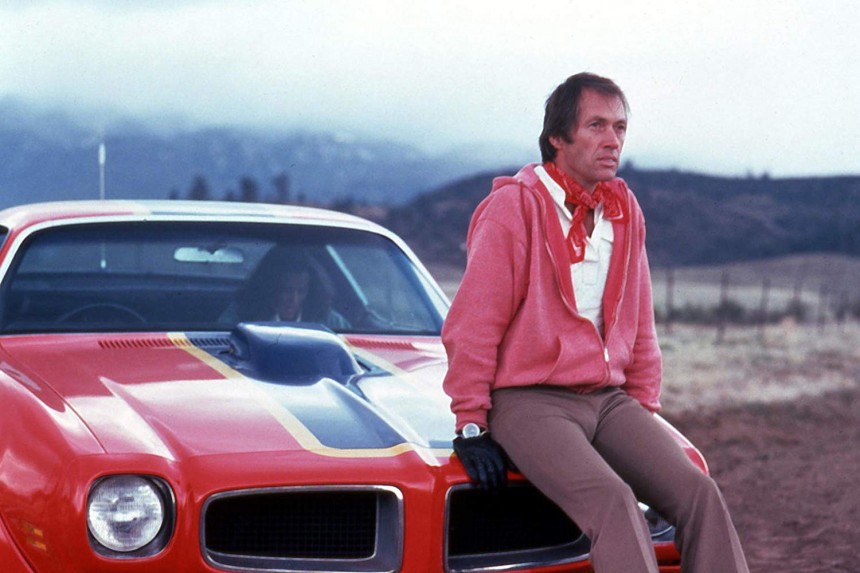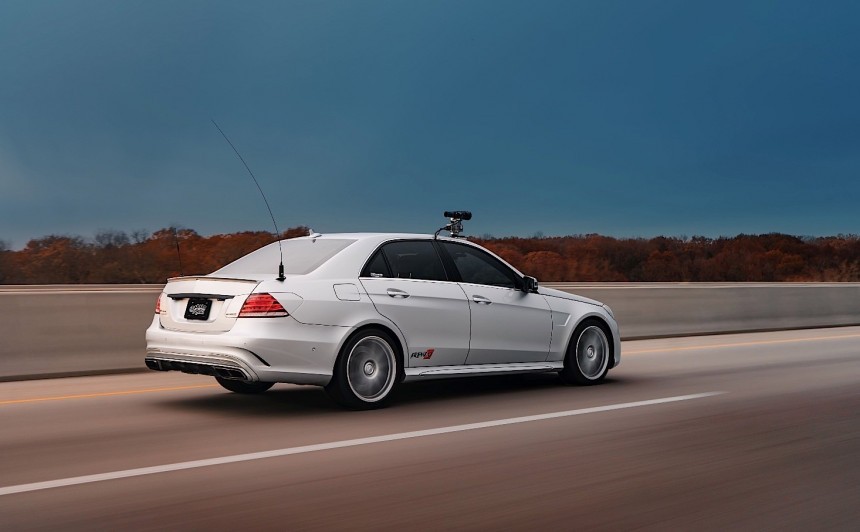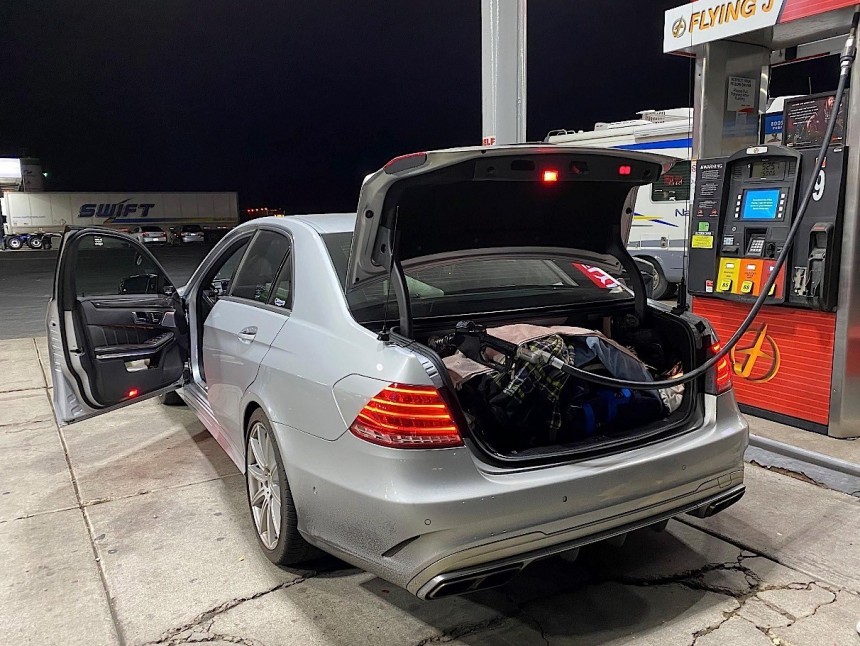An unofficial, unsanctioned and most of all illegal race from New York to Los Angeles has captivated the minds of petrolhead daredevils ever since the automobile started paving its way over the early roads of America.
Over the years, the event has inspired several Hollywood movies, a television series and thousands of press articles, so we decided to put all the major record-setting coast-to-coast runs that comprise the Cannonball Run in one way or another in a single article.
Since there have been hundreds of attempts in total, not all of them properly documented, we decided to only stick it to the records, beginning with the earliest one.
The first-ever cross-country speed record from New York to Los Angeles and the event that started this whole “Cannonball” craze was achieved by a racing driver called Erwin “Cannon Ball” Baker back in 1933.
Driving a 1932 Graham-Paige Blue Streak 8 Sedan, the original Cannonballer achieved the feat in 53 hours and 30 minutes, back in an era when America's interstate system wasn't even on the drawing board.
Beginning his career as a vaudeville performer but then abruptly switching to driving fast cars and riding motorcycles in increasingly daring exploits, Erwin Baker became famous for a variety of record-setting point-to-point races.
Most of his racing endeavors were actually paid promotions for miscellaneous companies like Cadillac, Chrysler or the now-defunct Stutz, and they pretty much culminated with the aforementioned Graham-Paige record, which stood unbeaten for almost four decades.
Fast-forward to the mid-1970s, when automotive writer Brock Yates conceived and then raced himself in the first NY to LA race to be called the Cannonball Run. The official name was actually a tribute to Erwin Baker's 1930s antics and was called “The Cannonball Baker Sea-To-Shining-Sea Memorial Trophy Dash.”
Ran five times from 1971 till 1979, the race was intended by Yates not necessarily as an illegal competition but to both celebrate the completed U.S. Interstate Highway System and protest against upcoming national traffic laws. Some baby boomers might remember that the U.S. had a national maximum speed limit of 55 mph (89 kph) from 1974 until 1987.
The second race of 1971 and the first one to be organized as a competition was won by none other than legendary Dan Gurney, who completed the feat alongside Brock Yates in just 35 hours and 54 minutes using a dark blue Ferrari 365 GTB/4 Daytona. Incidentally, the color of the car at high speeds was also a fitting tribute to Erwin Baker's “Blue Streak” Graham.
Speaking of speeds, Gurney would mention after the race that at no point during the trip did they exceed 175 mph (282 kph). Their average speed of about 80 mph (130 kph) is by no means impressive nowadays, but it helped the two swashbucklers complete the 2,863 miles (4,608 km) cross-country journey in 35 hours and 54 minutes.
Encountering snowy roads in the Rocky Mountains certainly didn't help their endeavor and they even collected a speeding fine along the way. Apparently, Gurney was clocked going 135 mph (217 kph) in a 70 mph zone in Arizona and received a citation.
Their record was beaten by a single minute in 1975, in another Ferrari, only this time it was a tiny Dino 246 GTS driven by Jack May and Rick Cline, who also appeared in a special coverage in Time Magazine.
Clearly inspired by it but with no official connection to the illegal cross country race, 1976 saw two Hollywood comedy films draw even more attention to Brock Yate's event. Cannonball! featured the late David Carradine's character participating in a so-called Trans-America Grand Prix with a fittingly named Pontiac Firebird Trans Am. The second movie was called The Gumball Rally and was also a tongue-in-cheek reference to Yate's race, as it saw the late Michael Sarrazin embarking on a coast-to-coast race in an AC Cobra “with no catalytic converter and no 55 mph speed limit.”
Brock Yates wrote a movie screenplay of his own, which resulted in 1981s The Cannonball Run, starring Hollywood legends like Burt Reynolds, Roger Moore, Dean Martin, Sammy Davis Jr., and even Jackie Chan.
The fastest time achieved in the 1971-to-1979 Cannonball Baker Sea-To-Shining-Sea Memorial Trophy Dash was 32 hours and 51 minutes and was established by Dave Heinz and Dave Yarborough, two Jaguar dealers, in a Jaguar XJS. The Jag somehow found a second life in recent years, having been saved from the crusher by Overhaulin's Richard Rawlings, who allegedly beat the 1979 record in 2007 with a modified Ferrari 550 Maranello.
With the 55 mph national speed limit full in force, Yates declined to continue the event past 1979, with the increase of highway traffic and police activity being a reason for the cancelation. Despite an outpour of public support following his Cannonball antiques being covered in the news all the time, he was obviously facing increased legal liabilities being the race organizer.
A slightly longer version of the Cannonball coast-to-coast race, called the U.S Express, took place from 1980 until 1983. With a time of 32 hours and 7 minutes being achieved in the final 1983 race, the fastest U.S. Express was about 44 minutes faster than the fastest Cannonball, but some purists don't consider them equivalent for not following a similar route.
Either way, that record stood until 2006, when Alex Roy and Dave Maher made a transcontinental run from New York to LA in just 31 hours and 4 minutes. The trip across 13 states was made in a BMW M5 E39 packed with radar detectors, night vision, triple-redundant GPS navigation, an extra fuel tank, freaking gyro-stabilized binoculars and a list of local-police radio frequencies for the CB radio.
Just like other Cannonballers before or after them, Roy and Maher had a cover for their unusual-looking M5 – it was filled with all those gadgets because they tried to pass as storm chasers on the hunt for a major atmospheric disturbance. Clever.
The 1970s took the cake for hilarious cover stories in case the police came a-knocking, though. A pair of participants who worked as ophthalmologists carried a bunch of pigs' eyes, which resemble human eyes, in a box marked “Rush to Eye Bank.” Others disguised as priests or used a van made to look like an ambulance with fully working lights as a record attempt vehicle.
The 2006 Roy and Maher run looked like it would never be beaten going forward since the increase in traffic has been atrocious on some stretches of the NY to LA route, but their record was simply shattered by Ed Bolian, co-driver Dave Black and wingman Dan Huang in 2013. They drove a seemingly inconspicuous 2004 Mercedes-Benz CL 55 AMG decked out with three fuel tanks, a police scanner, three radar detectors, two laser jammers, a CB radio and a kill switch for the taillights.
Their highly illegal cross-country trip from NY to LA took a staggering 28 hours and 50 minutes, simply obliterating all other records and feeling like it was there to stay for a long time.
Well, it looks like that time finally arrived a few days ago, when a team comprising Arne Toman, Doug Tabbutt and Berkeley Chadwick managed to enter the history books with a new “unbeatable” transcontinental record.
Their souped-up 2015 Mercedes-Benz E 63 AMG managed the feat in a mind-blowing 27 hours and 25 minutes. That's all it took for them to drive across the U.S. from the Red Ball Garage in Manhattan to the Portofino Hotel in Redondo Beach, Los Angeles.
Like many of their predecessors, Toman and Tabbutt tricked out their car in various ways to escape the long arm of the law, including a custom-fabricated fuel cell to hold more gas, two radar detectors, a laser jammer system and even an aircraft collision avoidance system to spot highway patrol aircraft.
Apart from a kill switch for the taillights, the modified E 63 AMG was also engulfed with several silver vinyl patches to make it look like a mid-2000s Honda Accord instead of a road-going demon sedan.
While the stock model is plenty fast, the record car was modified to develop around 850 horsepower on race fuel thanks to an Alpha 9 package from AMS Performance, Arne Toman's former company, and that includes new turbochargers, downpipes, intercoolers, and intake.
Their average speed over the 2,825 miles (4,546 kilometers) transcontinental run was 103 mph (166 kph), while the highest speed achieved at one point was no less 193 mph (311 kph). Quite a feat considering that they weren't even once stopped by police and not a single accident happened.
To put things into perspective, Google Maps says that their trip from the Red Ball Garage in New York to the Portofino Hotel in Los Angeles takes at least 41 hours if you don't encounter any traffic jams along the way, something that will happen on the twelfth of never. In other words, please never attempt this highly dangerous and illegal act.
While the 27 hours and 25 minutes coast-to-coast run is ripe for the taking by other daring madmen, it is unlikely it will be beaten very soon, especially since planets needed some aligning for the highly dangerous record run to happen in the first place.
You can check out more footage from the original Cannonball, U.S. Express and some of the modern runs in a documentary by APEX films, available on iTunes, Vimeo and Netflix.
Since there have been hundreds of attempts in total, not all of them properly documented, we decided to only stick it to the records, beginning with the earliest one.
The first-ever cross-country speed record from New York to Los Angeles and the event that started this whole “Cannonball” craze was achieved by a racing driver called Erwin “Cannon Ball” Baker back in 1933.
Beginning his career as a vaudeville performer but then abruptly switching to driving fast cars and riding motorcycles in increasingly daring exploits, Erwin Baker became famous for a variety of record-setting point-to-point races.
Most of his racing endeavors were actually paid promotions for miscellaneous companies like Cadillac, Chrysler or the now-defunct Stutz, and they pretty much culminated with the aforementioned Graham-Paige record, which stood unbeaten for almost four decades.
Fast-forward to the mid-1970s, when automotive writer Brock Yates conceived and then raced himself in the first NY to LA race to be called the Cannonball Run. The official name was actually a tribute to Erwin Baker's 1930s antics and was called “The Cannonball Baker Sea-To-Shining-Sea Memorial Trophy Dash.”
The second race of 1971 and the first one to be organized as a competition was won by none other than legendary Dan Gurney, who completed the feat alongside Brock Yates in just 35 hours and 54 minutes using a dark blue Ferrari 365 GTB/4 Daytona. Incidentally, the color of the car at high speeds was also a fitting tribute to Erwin Baker's “Blue Streak” Graham.
Speaking of speeds, Gurney would mention after the race that at no point during the trip did they exceed 175 mph (282 kph). Their average speed of about 80 mph (130 kph) is by no means impressive nowadays, but it helped the two swashbucklers complete the 2,863 miles (4,608 km) cross-country journey in 35 hours and 54 minutes.
Encountering snowy roads in the Rocky Mountains certainly didn't help their endeavor and they even collected a speeding fine along the way. Apparently, Gurney was clocked going 135 mph (217 kph) in a 70 mph zone in Arizona and received a citation.
Their record was beaten by a single minute in 1975, in another Ferrari, only this time it was a tiny Dino 246 GTS driven by Jack May and Rick Cline, who also appeared in a special coverage in Time Magazine.
Brock Yates wrote a movie screenplay of his own, which resulted in 1981s The Cannonball Run, starring Hollywood legends like Burt Reynolds, Roger Moore, Dean Martin, Sammy Davis Jr., and even Jackie Chan.
The fastest time achieved in the 1971-to-1979 Cannonball Baker Sea-To-Shining-Sea Memorial Trophy Dash was 32 hours and 51 minutes and was established by Dave Heinz and Dave Yarborough, two Jaguar dealers, in a Jaguar XJS. The Jag somehow found a second life in recent years, having been saved from the crusher by Overhaulin's Richard Rawlings, who allegedly beat the 1979 record in 2007 with a modified Ferrari 550 Maranello.
With the 55 mph national speed limit full in force, Yates declined to continue the event past 1979, with the increase of highway traffic and police activity being a reason for the cancelation. Despite an outpour of public support following his Cannonball antiques being covered in the news all the time, he was obviously facing increased legal liabilities being the race organizer.
Either way, that record stood until 2006, when Alex Roy and Dave Maher made a transcontinental run from New York to LA in just 31 hours and 4 minutes. The trip across 13 states was made in a BMW M5 E39 packed with radar detectors, night vision, triple-redundant GPS navigation, an extra fuel tank, freaking gyro-stabilized binoculars and a list of local-police radio frequencies for the CB radio.
Just like other Cannonballers before or after them, Roy and Maher had a cover for their unusual-looking M5 – it was filled with all those gadgets because they tried to pass as storm chasers on the hunt for a major atmospheric disturbance. Clever.
The 1970s took the cake for hilarious cover stories in case the police came a-knocking, though. A pair of participants who worked as ophthalmologists carried a bunch of pigs' eyes, which resemble human eyes, in a box marked “Rush to Eye Bank.” Others disguised as priests or used a van made to look like an ambulance with fully working lights as a record attempt vehicle.
The 2006 Roy and Maher run looked like it would never be beaten going forward since the increase in traffic has been atrocious on some stretches of the NY to LA route, but their record was simply shattered by Ed Bolian, co-driver Dave Black and wingman Dan Huang in 2013. They drove a seemingly inconspicuous 2004 Mercedes-Benz CL 55 AMG decked out with three fuel tanks, a police scanner, three radar detectors, two laser jammers, a CB radio and a kill switch for the taillights.
Their highly illegal cross-country trip from NY to LA took a staggering 28 hours and 50 minutes, simply obliterating all other records and feeling like it was there to stay for a long time.
Well, it looks like that time finally arrived a few days ago, when a team comprising Arne Toman, Doug Tabbutt and Berkeley Chadwick managed to enter the history books with a new “unbeatable” transcontinental record.
Like many of their predecessors, Toman and Tabbutt tricked out their car in various ways to escape the long arm of the law, including a custom-fabricated fuel cell to hold more gas, two radar detectors, a laser jammer system and even an aircraft collision avoidance system to spot highway patrol aircraft.
Apart from a kill switch for the taillights, the modified E 63 AMG was also engulfed with several silver vinyl patches to make it look like a mid-2000s Honda Accord instead of a road-going demon sedan.
While the stock model is plenty fast, the record car was modified to develop around 850 horsepower on race fuel thanks to an Alpha 9 package from AMS Performance, Arne Toman's former company, and that includes new turbochargers, downpipes, intercoolers, and intake.
To put things into perspective, Google Maps says that their trip from the Red Ball Garage in New York to the Portofino Hotel in Los Angeles takes at least 41 hours if you don't encounter any traffic jams along the way, something that will happen on the twelfth of never. In other words, please never attempt this highly dangerous and illegal act.
While the 27 hours and 25 minutes coast-to-coast run is ripe for the taking by other daring madmen, it is unlikely it will be beaten very soon, especially since planets needed some aligning for the highly dangerous record run to happen in the first place.
You can check out more footage from the original Cannonball, U.S. Express and some of the modern runs in a documentary by APEX films, available on iTunes, Vimeo and Netflix.
